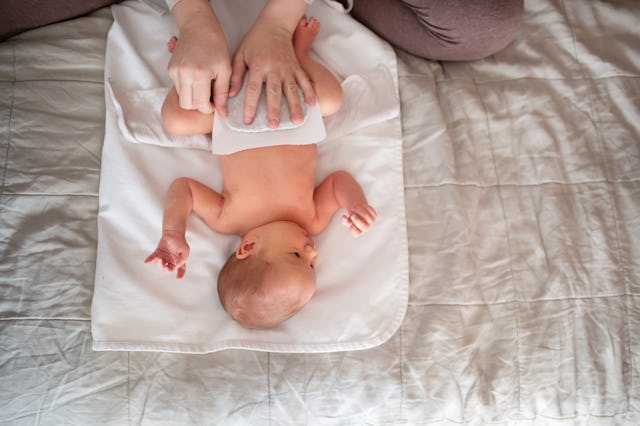Researchers Developed A "Smart Diaper" That Sends Notifications To Parents’ Phones
Necessary or completely ridiculous?

The future is here! Parents might not even have to look at their kids’ diapers to see if they need a changing now that a “smart diaper” has been developed with enough technology to send a mobile alert to a caregiver’s phone that their baby needs a change.
A Penn State-led research team has developed a simple pencil-on-paper design integrated with humidity sensors to create what they are calling: a “smart diaper.”
The study — published in the journal Nano Letters — describes the design behind the electrode sensor, which simply senses humidity levels that rise in the presence of you-know-what. “The sensor is created using a pencil, drawn on paper treated with a sodium chloride solution. The hydration sensor is highly sensitive to changes in humidity and provides accurate readings over a wide range of relative humidity levels, from 5.6% to 90%,” the study explains.
Once the sensor gets wet, the graphite reacts with the liquid and sodium chloride, and as the paper absorbs the liquid, electrons set off a sensor. Once the sensor detects the changes in humidity in the environment , the diaper — which is connected to a tiny lithium battery — powers data transmission to a smartphone via Bluetooth, alerting caregivers that a diaper change is needed.
Sure, you could just take a little peek, as parents have been doing for hundreds of years, but you could also do this.
Penn State researchers pride themselves on this “low-cost” technology.
“We wanted to develop something low-cost that people would understand how to make and use — and you can’t get more accessible than pencil and paper,” said Li Yang, professor in the School of Artificial Intelligence at China’s Hebei University of Technology.
“You don’t need to have some piece of multi-million-dollar equipment for fabrication. You just need to be able to draw within the lines of a pre-drawn electrode on a treated piece of paper. It can be done simply and quickly.”
The study was spearheaded by Penn State researchers’ goal of working on technology that will solve a problem before it snowballs into something irreversible.
“Our team has been focused on developing devices that can capture vital information for human health,” said Huanyu Cheng, the James L. Henderson, Jr. Memorial Associate Professor of Engineering Science and Mechanics at Penn State. “The goal is early prediction for disease conditions and health situations, to spot problems before it is too late.”
Cheng is also the father of two children and understands that sometimes when the little strip on the outside of the diaper turns blues, parents don’t always know how wet the diaper really is. He says that this “smart diaper” solves that problem.
“That application was actually born out of personal experience,” said Cheng.
“There’s no easy way to know how wet is wet, and that information could be really valuable for parents. The sensor can provide data in the short-term, to alert for diaper changes, but also in the long-term, to show patterns that can inform parents about the overall health of their child.”
While some may scoff at the idea of a “smart diaper,” remarking at how “lazy” this generation of parents has gotten, etc., there are actually some really interesting and beneficial aspects of this device — as well as opportunities to apply the technology elsewhere.
Not only could this save parents from wasting precious diapers by not having to change ones that are barely wet, it could also help parents and caregivers understand more about a child’s overall health and wellness. The more you read about this concept, the less outrageously unnecessary it seems and the more it seems like technology that could be useful in a variety of ways.
For example, the humidity sensors could eventually save lives. Researchers also tested the device in a face mask and found it could potentially provide data that could detect the onset of a heart attack or when someone stops breathing.
In other words: this might not be technology that shows up in grocery store aisles any time soon, but it’s moving the healthcare world forward. And until then, we’ll have to rely on the blue strip, the smell test, and other proven stinky diaper detection techniques.
Read the entire study here.